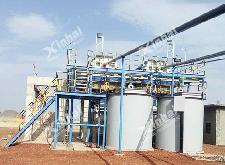

Warm Tip: If you want to know more details about equipment, solutions, etc, please click the button below for free consultation, or leave your requirements!
Hydrocyclone is an effective fine particle classifing equipment in the present mineral processing equipment. Its structure is relatively simple, with a cylinder on the top and a conical container on the bottom. The slurry is fed into the hydrocyclone at a certain speed along the tangential direction, which generates a large centrifugal force due to the rotary motion. Under the action of centrifugal force, the coarser particles are thrown toward the wall of the cyclone and move downwards along the spiral track, and finally discharged by the setting nozzle as coarse-grained products. And the finer particles and most of the water are discharged from the overflow pipe in the spiral path, so as to achieve the purpose of separation and classification.
In the classification process, the factors affecting the classification efficiency of the hydrocyclone are mainly the following 6 types:

The diameter of hydrocyclone determines the separation particle size and production capacity of hydrocyclone. When the ratio between the feed pressure, the feed port, the overflow port and the diameter of the hydrocyclone remains unchanged, the production capacity of the hydrocyclone will increase with the increase of the diameter of the hydrocyclone, and the separation particle size will also become thicker with the increase of the diameter of the hydrocyclone. Therefore, most mineral processing plants choose the specifications of the hydrocyclone according to the required overflow particle size, and even use multiple hydrocyclones in parallel.
The size of the feed port will affect the classification efficiency and production capacity of the hydrocyclone. Too large or too small feed port is not conducive to the classification effect. If the particle size of the ore feed is coarse and the feed pressure is low, the ratio of the diameter of the feed port to the diameter of the hydrocyclone can be slightly larger, generally 0.16 to 0.20 is appropriate. If particle size of the ore feed is fine and the feed pressure is high, the ratio of the feeding port to the diameter of the hydrocyclone is usually maintained at 0.14 to 0.16. In addition, the shape of the feed port (often rectangular) and the feeding method (tangent or involute) also have some effect on the classification efficiency.
The diameter of the setting nozzle can be adjusted in the actual classification operation. The larger the diameter of the setting nozzle, the lower the setting concentration, the smaller the overflow volume, and the smaller the overflow particle size. The smaller the setting nozzle diameter, the higher the setting concentration, the greater the overflow flow, and the higher the coarse particle content.
The diameter of the overflow pipe should maintain a certain ratio with the diameter of the hydrocyclone. If the diameter of the overflow pipe is increased, the overflow flow will increase, the overflow particle size will become thicker, the fine particle size content in sand setting will decrease, the sand setting concentration will increase, and the classification efficiency will decrease. In addition, the ratio of the depth of the overflow pipe to the height of the hydrocyclone column should be maintained at 0.7 to 0.8. If the depth of the overflow pipe is too large or too small, the overflow particle size will become coarse, and the fine particle content in the setting will increase, which will affect the classification efficiency.
The height of the column mainly affects the length of time the pulp is affected by centrifugal force, so it has a certain influence on the classification efficiency. In general, the height of the hydrocyclone cylinder is preferably 0.6 to 1.0 times of the diameter. The higher the column height, the finer the separation particle size. However, if the height of the column exceeds a certain limit, it will lose its effect due to the increase in the feed pressure loss.
The cone angle has an important influence on the classification efficiency of the hydrocyclone. The smaller the cone angle and the longer the cone (the distance between the overflow port and the setting nozzle), the larger the classification volume, which can strengthen the classification process of the ore particles in the hydrocyclone and facilitate the separation of fine-grained materials. When used for fine grained desliming, the cone angle is generally 10 ° to 15 °, and when used for coarse-grained classification, the cone angle is generally 20 ° to 45 °.
Now that 6 factors affecting hydrocyclones have been known, you can adjust the diameter, feeding port, setting nozzle, overflow pipe, column height and cone angle of hydrocyclones in a targeted way to effectively improve the classification efficiency of hydrocyclones. It is worth noting that maintaining the ideal classification efficiency of the hydrocyclone is a systematic project in which the factors are both interrelated and mutually restrictive. Each mineral processing plant must be thoughtful to obtain the ideal classification efficiency.
Last: Matters Needing Attention in the Use of Vibrating Screen
Next: Ball Mill VS AG Mill: What are the Similarities and Differences?
1Application of Hydrocyclone in Gold Ore Tailings
 0
0
 5144
5144
2Application of Hydrocyclone in the Classification and Concentration Process
 1
1
 3294
3294


What Are the Differences Between CIP and CIL?
 11289
11289
 0
0